Fall Herbicide Applications: Maximize Impact on Perennial Weeds
Many farmers have seen the benefits of applying systemic herbicides in the fall, especially for the control of perennial weeds (Figure 1). Dandelion control can be improved by over 20% with fall application timings (Figure 2), while the population of other perennial species will be reduced and shoot emergence is delayed the following spring, giving crops a competitive edge.
However, variable fall weather can affect herbicide performance. Here are four top tips to help you get the most out of this application window.
Tip #1 – Choose the most effective products, rate and tank-mixes based on the perennial weed that you are targeting. Table 1 summarizes the application rates and notes for perennial weeds listed on glyphosate product labels.
Table 1. Glyphosate rate and application notes associated with several common perennial weeds.
| Weed Species | Glyphosate (540 g/L) rate | Notes |
| Alfalfa (Medicago sativa) – stand termination | 1 to 1.34 L/acre | Allow 5 or more days after treatment before tillage. |
| Burdock (Arctium minus) | not listed on label as a sensitive species | Requires a tank-mix partner for control. |
| Canada fleabane (Conyza canadensis) | this species is resistant to glyphosate | Requires a tank-mix partner for control. |
| Canada thistle (Cirsium arvense) | 1.2 to 1.8 L/acre | Allow 5 or more days after treatment before tillage. |
| Dandelion (Taraxacum officianle) | 1.34 L/acre | Allow 7 or more days after treatment before tillage. |
| Field bindweed (Convolvulus arvensis) | 1.8 to 3.2 L/acre | Allow 7 or more days after treatment before tillage. |
| Perennial sow-thistle (Sonchus arvensis) | 1.8 to 3.2 L/acre | Allow 7 or more days after treatment before tillage. |
| Red clover (Trifolium arvense) – stand termination | not listed on label as a sensitive species | Requires a tank-mix partner for control. |
| Wild carrot (Daucus carota) | not listed on label as a sensitive species | Requires a tank-mix partner for control. |
| Vetch, tufted (Viccia cracca) | this species is very tolerant to glyphosate | Requires a tank-mix partner for control. |
Table 2. Herbicides that can be tank-mixed with glyphosate to improve the control of more tolerant/resistant species. Often a glyphosate rate of 1.34 L/acre is used. Note that some of these herbicides have plant back restrictions that if not followed, could result in unacceptable crop injury.
| Herbicide (active ingredient) | Product Rate | Sensitive species | Plant back restrictions |
| 2,4-D ester 700 (2,4-D at 660 gae/L) | 0.7 L/acre | Alfalfa, Canada thistle, field bindweed, perennial sow-thistle | Must wait a minimum of 30 days before planting to rotational crops. |
| Distinct (diflufenzopyr/dicamba) + Merge adjuvant | 115 g/acre + 200 mL/acre | Canada fleabane, Canada thistle, dandelion, field bindweed, perennial sow-thistle, red clover, tufted vetch | Must wait a minimum of 30 days before planting to rotational crops. |
| Express SG (tribenuron-methyl) | 6 to 12 g/acre | Burdock*, dandelion, scentless chamomile, wild carrot, tufted vetch (* 12 g/acre rate needed). | Most field crops can be safely grown the following spring. |
| Lontrel XC (clopyralid) | 200 mL/acre | Alfalfa, Canada fleabane, Canada thistle, perennial sow-thistle, red clover | Cannot plant alfalfa, dry beans, clover or soybean the following spring. |
Tip #2 – Apply herbicides when air temperatures stay above 8°C for at least two hours after spraying. Late morning to mid-day is ideal, as plants absorb herbicides more effectively during the warmest part of the day.
Tip #3 – Watch for Frost Damage Before Resuming Applications
After a frost, wait 2–3 days before assessing weed condition. If target plants appear healthy and temperatures are above 8°C, herbicide applications can resume.
For example, bolted Canada fleabane is highly frost-sensitive. Figure 3 shows a plant three days after a -3°C night—its damaged leaves would poorly absorb glyphosate. In contrast, seedling Canada fleabane (basal rosette stage), dandelion, and wild carrot were unaffected by the same frost (Figures 4, 5, and 6), and remain suitable for treatment based on leaf condition.
Tip #4 – Delay Tillage After Herbicide Application
Wait at least 72 hours after spraying perennial weeds before tilling, and longer if label guidelines recommend it. The more time the herbicide has to translocate within the plant, the more effective the control.
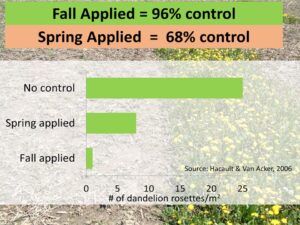
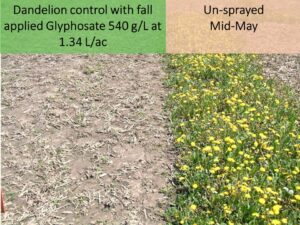
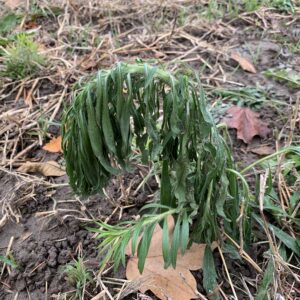
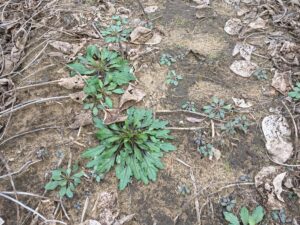
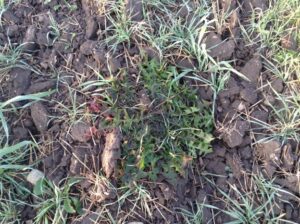
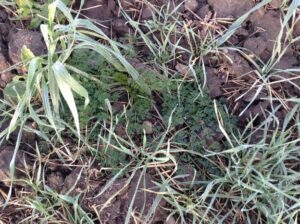
OMAFA Weather Summary: Thurs Sept 11—Wed Sept 17 2025
| Location | Highest Temp (°C) | Lowest Temp (°C) | Rain for Week (mm) | Rain Since April 1st (mm) | GDD0C April 1st | GDD5C April 1st | CHU May 1st |
| HARROW | |||||||
| 2025 | 27.6 | 9.9 | 0.0 | 400.7 | 2966 | 2138 | 3224 |
| 2024 | 27.7 | 12.3 | 0.0 | 452.5 | 3142 | 2290 | 3446 |
| 2023 | 23.0 | 7.4 | 6.5 | 586.7 | 2867 | 2033 | 3134 |
| 10 YR Norm (2011-2020) | 23.9 | 10.8 | 11.9 | 507.5 | 2991 | 2144 | 3402 |
| RIDGETOWN | |||||||
| 2025 | 26.7 | 8.9 | 0.0 | 330.4 | 2816 | 1991 | 3010 |
| 2024 | 28.0 | 11.1 | 0.0 | 551.6 | 2976 | 2129 | 3236 |
| 2023 | 24.0 | 5.9 | 8.5 | 512.8 | 2736 | 1910 | 2937 |
| 10 YR Norm (2011-2020) | 24.0 | 8.6 | 7.6 | 460.0 | 2819 | 1977 | 3168 |
| SARNIA | |||||||
| 2025 | 25.2 | 8.9 | 0.0 | 485.0 | 2783 | 1963 | 2954 |
| 2024 | 29.1 | 11.5 | 0.2 | 466.1 | 2989 | 2145 | 3239 |
| 2023 | 22.3 | 7.8 | 30.0 | 480.8 | 2708 | 1884 | 2886 |
| 10 YR Norm (2011-2020) | 23.1 | 10.1 | 12.1 | 464.7 | 2800 | 1960 | 3166 |
| LONDON | |||||||
| 2025 | 28.3 | 9.9 | 0.0 | 338.1 | 2731 | 1932 | 2958 |
| 2024 | 27.3 | 10.3 | 0.0 | 554.9 | 2952 | 2101 | 3223 |
| 2023 | 22.6 | 5.6 | 16.3 | 560.9 | 2716 | 1892 | 2926 |
| 10 YR Norm (2011-2020) | 23.9 | 9.4 | 11.8 | 482.8 | 2792 | 1953 | 3143 |
| BRANTFORD | |||||||
| 2025 | 27.9 | 9.0 | 0.0 | 370.2 | 2770 | 1958 | 2922 |
| 2024 | 28.6 | 7.8 | 0.0 | 460.2 | 2894 | 2049 | 3148 |
| 2023 | 24.3 | 4.2 | 1.1 | 446.1 | 2696 | 1870 | 2891 |
| 10 YR Norm (2011-2020) | 25.2 | 9.2 | 5.1 | 414.9 | 2792 | 1957 | 3108 |
| WELLAND | |||||||
| 2025 | 27.2 | 9.5 | 0.0 | 313.6 | 2823 | 2002 | 3032 |
| 2024 | 28.7 | 8.3 | 0.0 | 472.6 | 2966 | 2117 | 3257 |
| 2023 | 24.3 | 6.1 | 1.4 | 506.8 | 2756 | 1924 | 2982 |
| 10 YR Norm (2011-2020) | 23.1 | 9.3 | 17.7 | 431.6 | 2811 | 1972 | 3171 |
| GODERICH | |||||||
| 2025 | 25.2 | 8.3 | 0.0 | 300.9 | 2616 | 1806 | 2814 |
| 2024 | 27.7 | 11.9 | 0.0 | 369.8 | 2739 | 1900 | 2987 |
| 2023 | 21.0 | 5.7 | 14.2 | 378.3 | 2525 | 1717 | 2702 |
| 10 YR Norm (2011-2020) | 21.4 | 9.0 | 8.6 | 426.0 | 2575 | 1745 | 2913 |
| ELORA | |||||||
| 2025 | 26.6 | 9.2 | 0.3 | 385.3 | 2555 | 1753 | 2722 |
| 2024 | 26.9 | 8.1 | 1.1 | 425.3 | 2680 | 1844 | 2909 |
| 2023 | 22.9 | 4.4 | 33.9 | 478.1 | 2498 | 1689 | 2653 |
| 10 YR Norm (2011-2020) | 22.8 | 6.6 | 10.6 | 477.5 | 2523 | 1697 | 2805 |
| MOUNT FOREST | |||||||
| 2025 | 25.9 | 7.4 | 0.9 | 373.2 | 2564 | 1766 | 2741 |
| 2024 | 27.1 | 10.9 | 0.0 | 401.4 | 2679 | 1847 | 2923 |
| 2023 | 21.5 | 4.7 | 11.1 | 416.5 | 2492 | 1688 | 2656 |
| 10 YR Norm (2011-2020) | 22.0 | 7.6 | 8.2 | 489.6 | 2513 | 1695 | 2829 |
| BARRIE | |||||||
| 2025 | 25.3 | 7.1 | 1.3 | 314.3 | 2564 | 1762 | 2733 |
| 2024 | 27.6 | 7.2 | 0.0 | 558.8 | 2636 | 1803 | 2877 |
| 2023 | 22.8 | 3.9 | 11.7 | 508.9 | 2504 | 1695 | 2681 |
| 10 YR Norm (2011-2020) | 22.0 | 7.3 | 10.0 | 433.2 | 2483 | 1669 | 2776 |
| PETERBOROUGH | |||||||
| 2025 | 26.4 | 4.6 | 0.0 | 337.8 | 2595 | 1783 | 2720 |
| 2024 | 29.0 | 4.8 | 0.0 | 445.8 | 2669 | 1831 | 2853 |
| 2023 | 25.1 | 1.5 | 19.6 | 430.4 | 2561 | 1739 | 2686 |
| 10 YR Norm (2011-2020) | 23.2 | 5.6 | 15.2 | 428.6 | 2553 | 1727 | 2798 |
| KEMPTVILLE | |||||||
| 2025 | 27.2 | 3.9 | 0.0 | 288.5 | 2740 | 1926 | 2913 |
| 2024 | 29.0 | 10.0 | 0.0 | 552.6 | 2836 | 1998 | 3104 |
| 2023 | 23.5 | 5.5 | 6.4 | 515.9 | 2718 | 1902 | 2895 |
| 10 YR Norm (2011-2020) | 23.4 | 7.6 | 18.9 | 478.6 | 2684 | 1859 | 2995 |
| SUDBURY | |||||||
| 2025 | 25.8 | 4.0 | 0.4 | 366.2 | 2302 | 1534 | 2494 |
| 2024 | 27.7 | 10.8 | 0.5 | 500.7 | 2502 | 1694 | 2740 |
| 2023 | 21.9 | 6.5 | 14.5 | 529.5 | 2356 | 1588 | 2527 |
| 10 YR Norm (2011-2020) | 21.3 | 7.1 | 9.5 | 454.0 | 2348 | 1584 | 2668 |
| EARLTON | |||||||
| 2025 | 27.6 | 0.3 | 0.9 | 382.1 | 2228 | 1476 | 2406 |
| 2024 | 28.9 | 9.7 | 0.0 | 484.3 | 2455 | 1653 | 2653 |
| 2023 | 22.0 | 4.2 | 20.6 | 407.5 | 2317 | 1548 | 2459 |
| 10 YR Norm (2011-2020) | 20.6 | 5.4 | 18.9 | 431.5 | 2190 | 1448 | 2465 |
| SAULT STE MARIE | |||||||
| 2025 | 27.5 | 10.3 | 0.2 | 423.0 | 2294 | 1517 | 2464 |
| 2024 | 25.7 | 12.6 | 0.0 | 521.8 | 2362 | 1539 | 2546 |
| 2023 | 22.3 | 2.7 | 6.9 | 398.6 | 2290 | 1519 | 2429 |
| 10 YR Norm (2011-2020) | 21.5 | 5.9 | 14.0 | 479.1 | 2161 | 1398 | 2385 |
| THUNDER BAY | |||||||
| 2025 | 27.3 | 8.6 | 0.8 | 410.8 | 2140 | 1392 | 2346 |
| 2024 | 28.7 | 9.8 | 1.9 | 343.0 | 2274 | 1475 | 2423 |
| 2023 | 21.1 | -0.6 | 4.9 | 305.0 | 2154 | 1407 | 2320 |
| 10 YR Norm (2011-2020) | 21.5 | 5.0 | 16.2 | 420.7 | 2106 | 1353 | 2319 |
| FORT FRANCES | |||||||
| 2025 | 28.7 | 6.4 | 37.2 | 408.4 | 2333 | 1550 | 2544 |
| 2024 | 28.7 | 9.9 | 47.0 | 476.0 | 2364 | 1555 | 2562 |
| 2023 | 18.9 | -3.1 | 1.1 | 312.4 | 2310 | 1556 | 2508 |
| 10 YR Norm (2011-2020) | 21.3 | 4.8 | 13.0 | 419.3 | 2231 | 1459 | 2468 |
This weather summary is compiled by OMAFA using Environment Canada weather station data provided by Agriculture and Agri-Food Canada. Data quality is verified but accuracy is not guaranteed and should be used for general information purposes only. For additional locations and weather analysis, visit the OMAFA Pest and Weather System (PAWS)